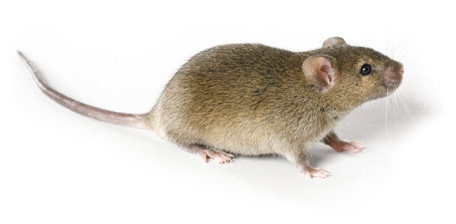The Jackson Laboratory’s C3H/HeJ strain (Stock Number 000659) is homozygous for a paracentric chromosomal inversion of Chromosome (Chr) 6. There is no apparent effect on the phenotype of mice with the inversion and its presence should not affect the use of C3H/HeJ mice for most biological studies. However, genetic studies involving Chromosome 6 will be seriously affected because inversions suppress recombination across their entire length when heterozygous.
The inversion was identified by Ellen Akeson of The Jackson Laboratory Cytogenetic Resource in a C3H/HeJ-derived congenic strain obtained by Jackson Laboratory Senior Staff Scientist Wesley Beamer, Ph.D., in 1996. Mice of this strain  exhibited suppression of recombination on Chr 6 during construction of the congenic line. C3H/HeJ mice from our foundation stocks were examined using chromosomal fluorescent in situ hybridization (FISH) and the presence of the inversion was verified. C3H/HeSnJ (Stock Number 000661) mice were also tested and do not harbor the inversion. All other C3H substrains distributed by The Jackson Laboratory's production and resource colonies are unlikely to carry the inversion because they have been separated from C3H/HeJ for more than 50 years. Frozen embryo stocks and spontaneous mutations that have arisen in C3H/HeJ mice are being analyzed to better define the timeline for fixation of this inversion.
exhibited suppression of recombination on Chr 6 during construction of the congenic line. C3H/HeJ mice from our foundation stocks were examined using chromosomal fluorescent in situ hybridization (FISH) and the presence of the inversion was verified. C3H/HeSnJ (Stock Number 000661) mice were also tested and do not harbor the inversion. All other C3H substrains distributed by The Jackson Laboratory's production and resource colonies are unlikely to carry the inversion because they have been separated from C3H/HeJ for more than 50 years. Frozen embryo stocks and spontaneous mutations that have arisen in C3H/HeJ mice are being analyzed to better define the timeline for fixation of this inversion.
An inversion in Chromosome 6 has been detected in C3H/HeJ strain (Stock Number 000659) mice.
Use of C3H/HeJ mice for genetic analysis of Chromosome 6 should be avoided or carried out with extreme caution. The end points of the inversion are at or very near D6Mit124 and D6Mit150. BACs from the RPCI-23 mouse library were used to define the extent of the inversion. BAC #294-I-15 at ~72.9 Mb (Ensembl) just distal to D6Mit124 and BAC #37-K-24 at ~116.5 Mb just proximal to D6Mit150 are within the inversion. D6Mit124 is at 30.3 cM (cytological band C3) and D6Mit150 is at 51.0 cM (cytological band F1) on the Mouse Genome Database (MGD) composite genetic map. BAC #92-M-3 at 53 Mb just distal to D6Mit93, which is at 26.29 cM (cytological band B3) on the MGD map, is outside of the inversion. The inversion encompasses about 20% of Chr 6. Genes and mutations that map within this region include the Igk complex, motor neuron degeneration 2 (mnd2), truncate (tc) and faded (fe).
In summary, we have found that C3H/HeJ mice are fixed for a chromosomal inversion of Chr 6. Current data indicates that this inversion occurred sometime after separation of C3H/HeJ from C3H/HeSnJ and prior to 1996. The Jackson Laboratory is currently in the process of determining how long the inversion has been present in our production colony. A decision as to whether we can eliminate the inversion from the existing colony will be made when we have gathered more definitive data. Further updates on the status of this strain will be forthcoming. Please direct questions to our Technical Information Services staff by calling 800.422.6423 or 207.288.5845.